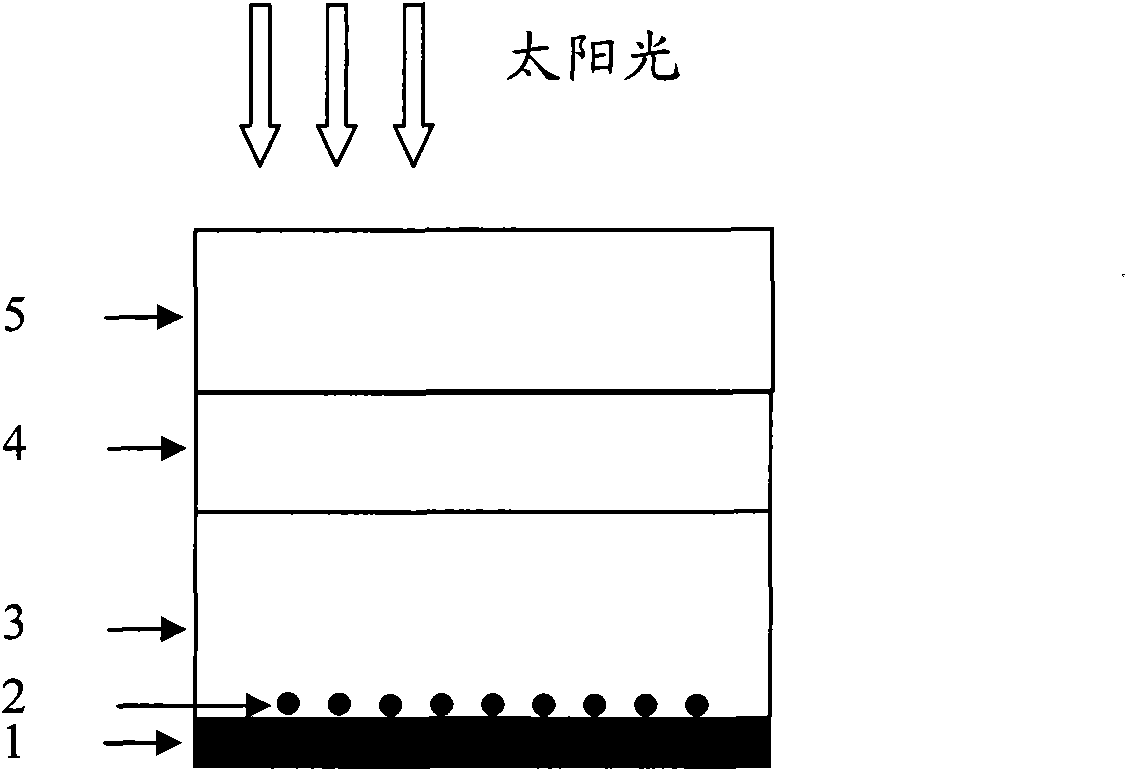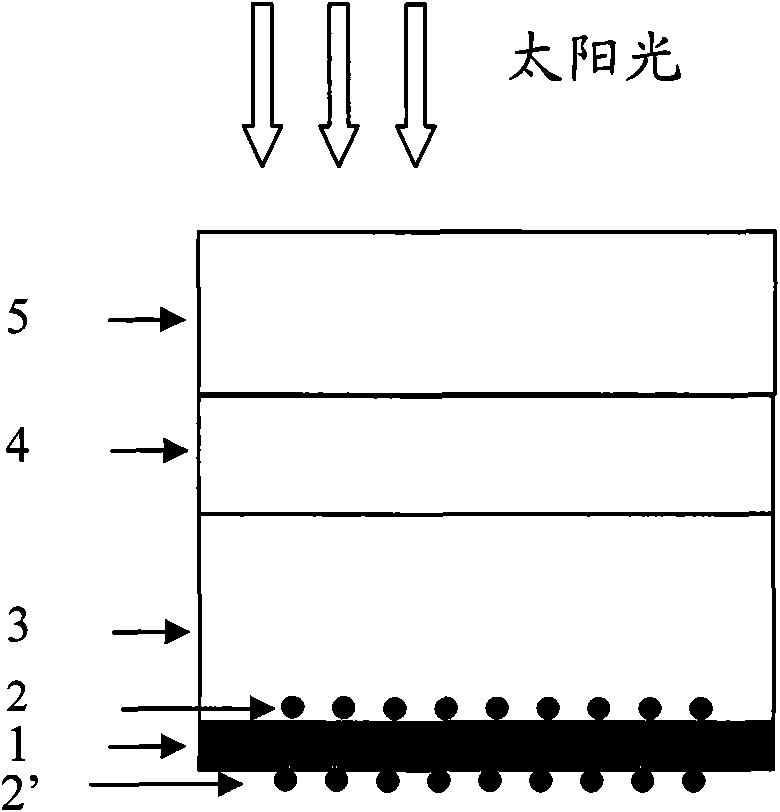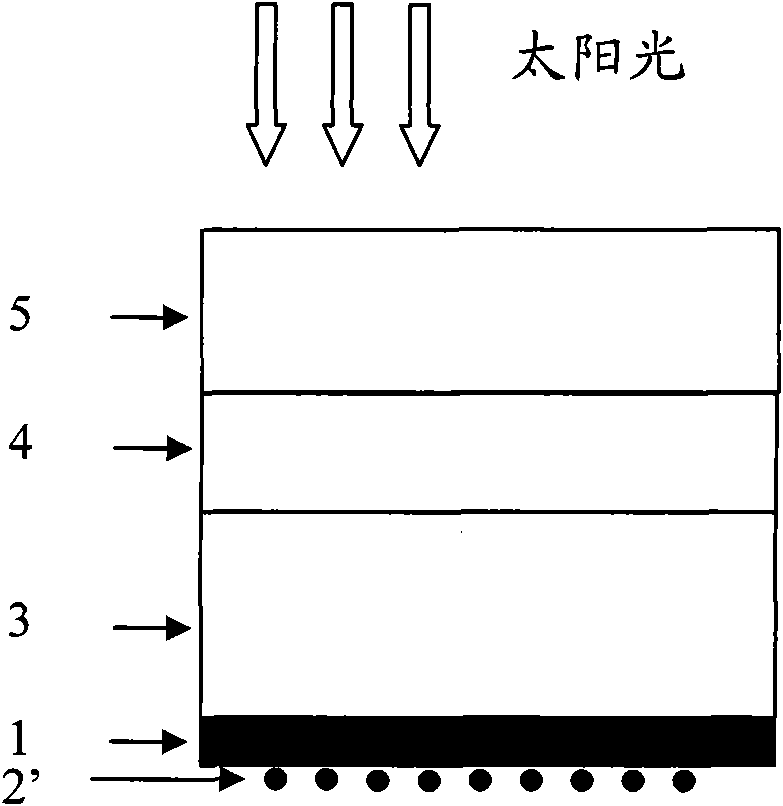Single-layer organic solar cell and making method thereof
A solar cell and organic technology, which is applied in circuits, photovoltaic power generation, electrical components, etc., can solve the problems of increasing the complexity of organic solar cell devices and demanding heterojunction growth control, so as to improve energy conversion efficiency and high production efficiency , the effect of reducing production costs
- Summary
- Abstract
- Description
- Claims
- Application Information
AI Technical Summary
Problems solved by technology
Method used
Image
Examples
Embodiment approach
[0020] see figure 1 , showing a schematic structural view of a first embodiment of a single-layer organic solar cell according to an embodiment of the present invention. In this embodiment, the single-layer organic solar cell includes a transparent insulating substrate 5, and a transparent anode electrode layer 4, a photosensitive layer 3, a metal nanoparticle layer 2, and a cathode electrode layer 1 sequentially stacked on the transparent insulating substrate 5. . Since the work function value of the metal nanoparticles in the metal nanoparticle layer 2 is lower than that of the cathode electrode layer 1, the cathode electrode layer 1 is chemically stable and difficult to be oxidized, while the metal nanoparticles in the metal nanoparticle layer are chemically stable. It is lively and easily oxidized. In this embodiment, the metal nanoparticle layer 2 is arranged between the photosensitive layer 3 and the cathode electrode layer 1, that is, the metal nanoparticle layer 2 is ...
Embodiment 1
[0050] The structure of a single-layer organic solar cell is as figure 1 As shown, the high-reflectivity cathode electrode layer 1 adopts an aluminum film electrode, the metal nanoparticle 2 is a lithium (Li) nanoparticle, the photosensitive layer 3 adopts a CuPc copper phthalocyanine thin film, and the transparent electrode 4 adopts an ITO stripe electrode, and its sheet resistance is 15 Ohm / □, the transparent insulating layer 5 is made of quartz glass.
[0051] Its specific preparation method is as follows:
[0052] (1) Select polished quartz glass with a thickness of 1.1mm as the transparent insulating substrate 5, and use an ultrasonic method to clean the quartz glass for 2-3 hours;
[0053] (2) adopt the method for sputtering to grow one deck ITO conductive thin film on one surface of quartz glass, and the thickness of ITO thin film is 120nm;
[0054] (3) Photoetching the ITO conductive film into the required striped electrode pattern as the transparent anode electrode ...
Embodiment 2
[0060] Such as figure 2 As shown, the high-reflectivity electrode 1 adopts Ag silver film electrode, the metal nanoparticle 2 adopts lithium Li nanoparticle, the photosensitive layer 3 adopts pentacene thin film, and the transparent electrode 4 adopts ITO stripe electrode, and its square resistance is 15 ohms / □, The transparent insulating layer 5 adopts quartz glass.
[0061] Its specific preparation method is as follows:
[0062] (1) Select polished quartz glass with a thickness of 1.5mm as the transparent insulating substrate 5, and use an ultrasonic method to clean the quartz glass for 2-2.5 hours;
[0063] (2) adopt the method for sputtering to grow one deck ITO conductive thin film on one surface of quartz glass, and the thickness of ITO thin film is 80nm;
[0064] (3) Photoetching the ITO conductive film into the required stripe electrode pattern as the anode of the solar cell; as the transparent anode electrode layer 4, that is, the anode of the battery;
[0065] (4...
PUM
| Property | Measurement | Unit |
|---|---|---|
| Thickness | aaaaa | aaaaa |
| Thickness | aaaaa | aaaaa |
| Thickness | aaaaa | aaaaa |
Abstract
Description
Claims
Application Information
 Login to View More
Login to View More - R&D
- Intellectual Property
- Life Sciences
- Materials
- Tech Scout
- Unparalleled Data Quality
- Higher Quality Content
- 60% Fewer Hallucinations
Browse by: Latest US Patents, China's latest patents, Technical Efficacy Thesaurus, Application Domain, Technology Topic, Popular Technical Reports.
© 2025 PatSnap. All rights reserved.Legal|Privacy policy|Modern Slavery Act Transparency Statement|Sitemap|About US| Contact US: help@patsnap.com



